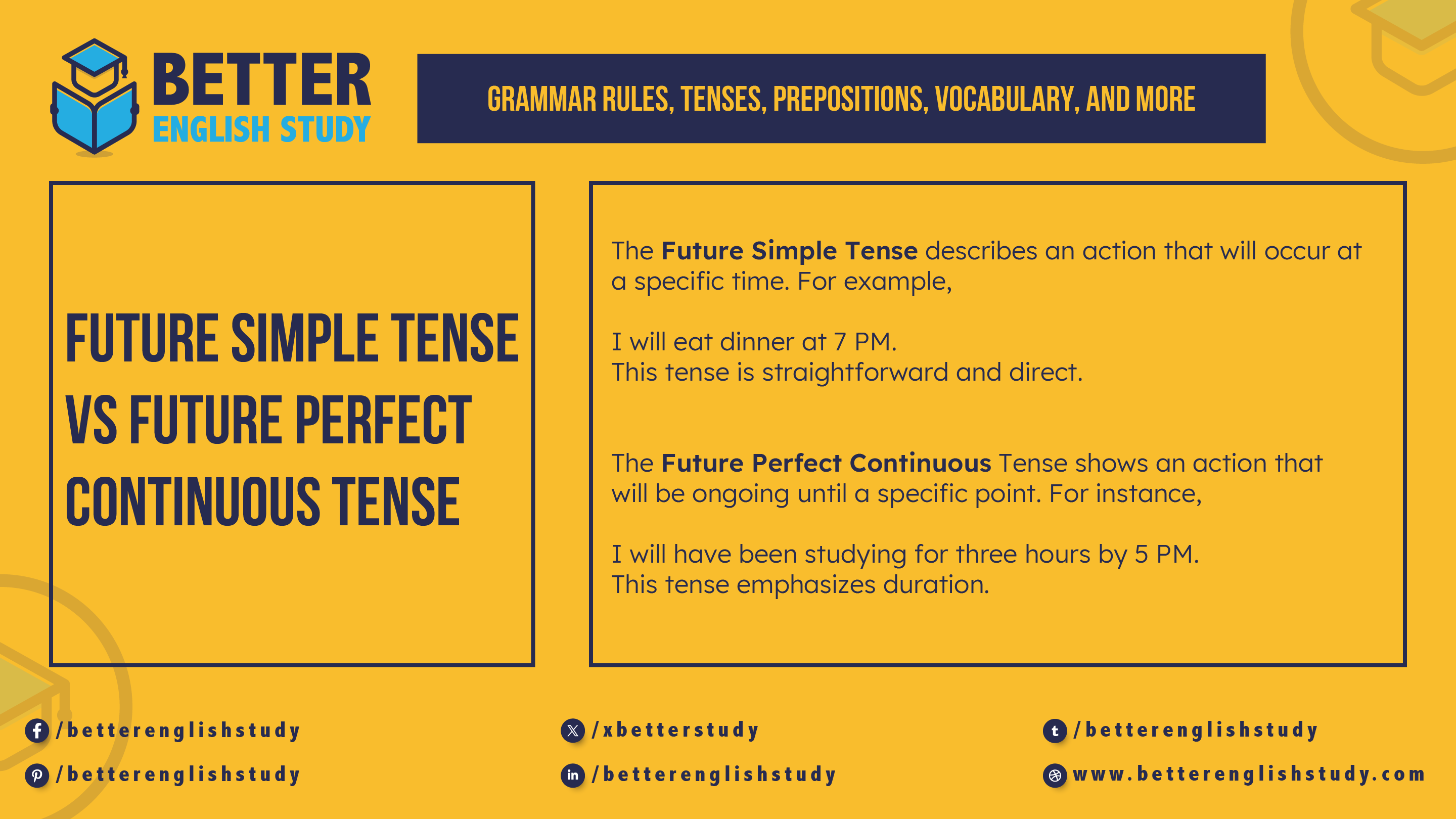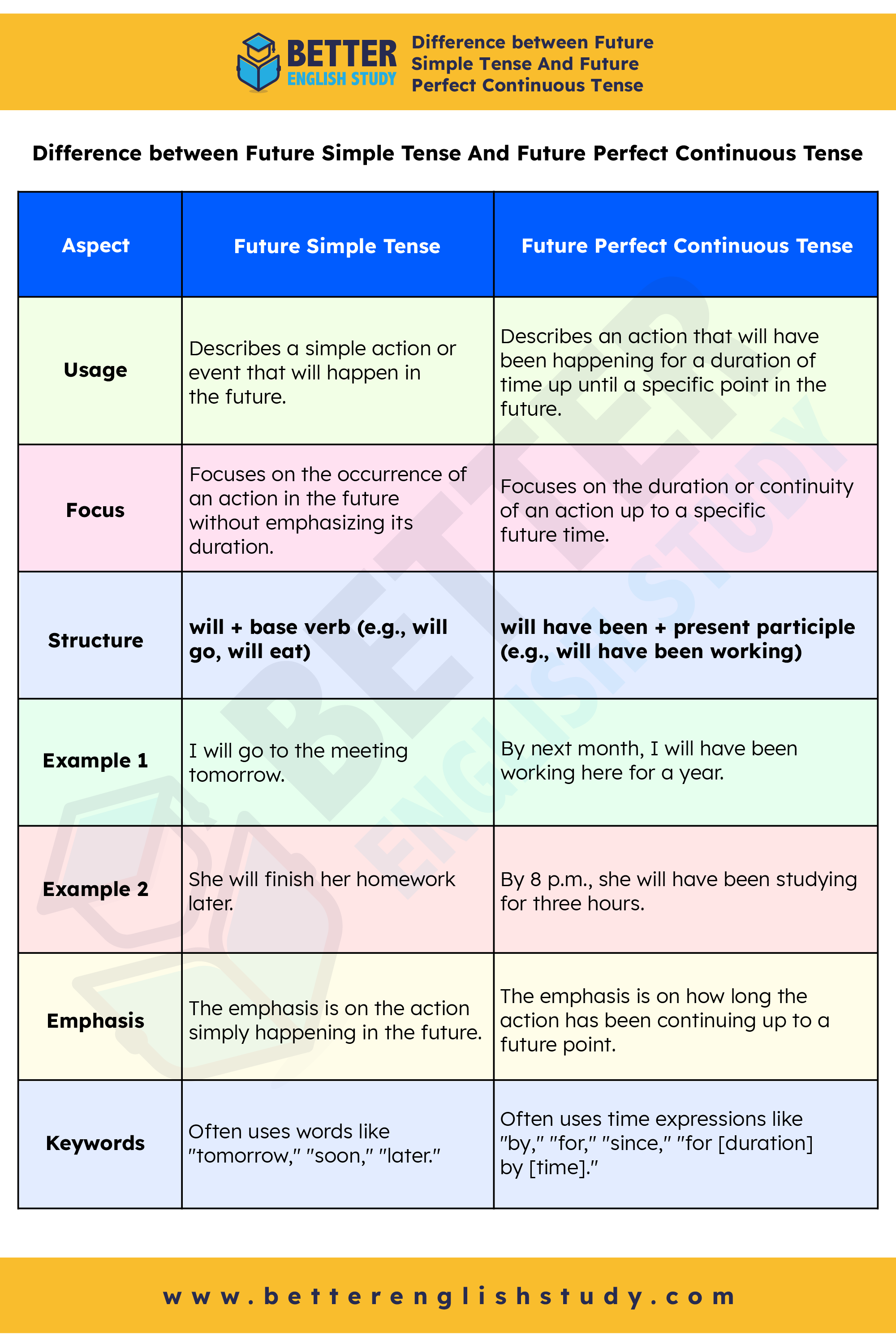
The Future Simple Tense expresses an action that will occur in the future, while the Future Perfect Continuous Tense indicates an ongoing action that will continue up until a specified point in the future. For example, “I will eat dinner” (Future Simple) versus “I will have been eating dinner for an hour by 7 PM” (Future Perfect Continuous).
Understanding English tenses is crucial for clear communication. Each tense carries distinct meanings and implications about time. The Future Simple Tense is straightforward, often used for predictions or decisions made at the moment. In contrast, the Future Perfect Continuous Tense highlights duration and emphasizes the ongoing nature of an action before another future moment.
Mastering these tenses can enhance your writing and speaking skills, making your English more precise and engaging.
Introduction To Future Tenses
Future tenses are essential in English grammar. They help express actions that will happen. Understanding their differences is crucial for clear communication.
The Future Simple Tense describes an action that will occur at a specific time. For example, “I will eat dinner at 7 PM.” This tense is straightforward and direct.
The Future Perfect Continuous Tense shows an action that will be ongoing until a specific point. For instance, “I will have been studying for three hours by 5 PM.” This tense emphasizes duration.
Knowing these tenses improves writing and speaking skills. It allows for more accurate descriptions of future events. Mastering them can greatly enhance your English proficiency.
Future Simple Tense
The Future Simple Tense describes actions that will happen later. It uses the structure “will” + base form of the verb. For example, “I will eat lunch” shows a future action.
Another example is “She will play soccer tomorrow.” This shows a planned activity. The future simple tense is easy to form and understand.
Commonly, it expresses promises or predictions. For instance, “He will help you.” This indicates a promise. Similarly, “It will rain tomorrow” shows a prediction about the weather.
Future Perfect Continuous Tense
Future Perfect Continuous Tense describes actions that will continue until a specific time in the future.
The structure includes the subject, followed by will have been, and the verb+ing. For example:
- She will have been studying for three hours by 5 PM.
- They will have been working here for ten years next month.
Use this tense to show duration. It emphasizes the process of an action.
Examples:
- He will have been playing soccer for two hours by 6 PM.
- We will have been traveling for five days by Saturday.

Difference between Future Simple Tense And Future Perfect Continuous Tense
| Aspect | Future Simple Tense | Future Perfect Continuous Tense |
|---|---|---|
| Usage | Describes a simple action or event that will happen in the future. | Describes an action that will have been happening for a duration of time up until a specific point in the future. |
| Focus | Focuses on the occurrence of an action in the future without emphasizing its duration. | Focuses on the duration or continuity of an action up to a specific future time. |
| Structure | will + base verb (e.g., will go, will eat) | will have been + present participle (e.g., will have been working) |
| Example 1 | I will go to the meeting tomorrow. | By next month, I will have been working here for a year. |
| Example 2 | She will finish her homework later. | By 8 p.m., she will have been studying for three hours. |
| Emphasis | The emphasis is on the action simply happening in the future. | The emphasis is on how long the action has been continuing up to a future point. |
| Keywords | Often uses words like “tomorrow,” “soon,” “later.” | Often uses time expressions like “by,” “for,” “since,” “for [duration] by [time].” |
- Future simple describes actions that will occur in the future.
- Future perfect continuous focuses on actions that will have been ongoing for a period of time up to a point in the future.
Formulating Sentences
To construct Future Simple sentences, use the formula: subject + will + base verb. For example, “I will play soccer.” This shows an action that will happen later. Other examples include “She will read a book” and “They will visit us.”
For Future Perfect Continuous, the formula is: subject + will have been + verb-ing. It describes an action that will continue until a specific point in the future. For example, “I will have been studying for three hours.” More examples are “She will have been working here for five years” and “They will have been traveling for two weeks.”
Common Mistakes
Many people misuse tenses in writing. The future simple tense describes actions that will happen. For example, “I will eat lunch.” This indicates a specific action in the future.
On the other hand, the future perfect continuous tense shows an action that will continue until a certain point. An example is, “I will have been eating lunch for an hour.” This emphasizes the duration of the action.
To avoid confusion, it’s important to remember their distinct uses. Overcomplicating sentences can lead to mistakes. Keep sentences clear and simple for better understanding.
Frequently Asked Questions
What Is Future Simple Tense?
Future Simple Tense indicates actions that will happen at a later time. It is formed using “will” or “shall” plus the base verb. For example, “I will eat dinner. ” It highlights intentions or predictions about future events, making it straightforward and easy to understand.
What Is Future Perfect Continuous Tense?
Future Perfect Continuous Tense describes ongoing actions that will continue up until a specified future point. It is formed using “will have been” plus the present participle. For instance, “I will have been studying for three hours. ” This tense emphasizes the duration of an action in the future.
How To Use Future Simple Tense?
Use Future Simple Tense to express promises, predictions, or plans. For example, “She will call you tomorrow. ” It’s often used in informal conversations and can express certainty or uncertainty about future events. This makes it versatile for various contexts, from casual chats to formal discussions.
How To Form Future Perfect Continuous Tense?
To form Future Perfect Continuous Tense, use “will have been” followed by the verb ending in -ing. For example, “They will have been working here for a year. ” This structure helps convey the ongoing nature of an action leading up to a future time, providing clarity in communication.
Conclusion
Understanding the differences between Future Simple and Future Perfect Continuous tenses is essential for effective communication. Each tense serves a unique purpose, helping convey distinct timelines and actions. By mastering these tenses, you can enhance your writing and speaking skills.
Practice with examples to solidify your grasp of these concepts.
